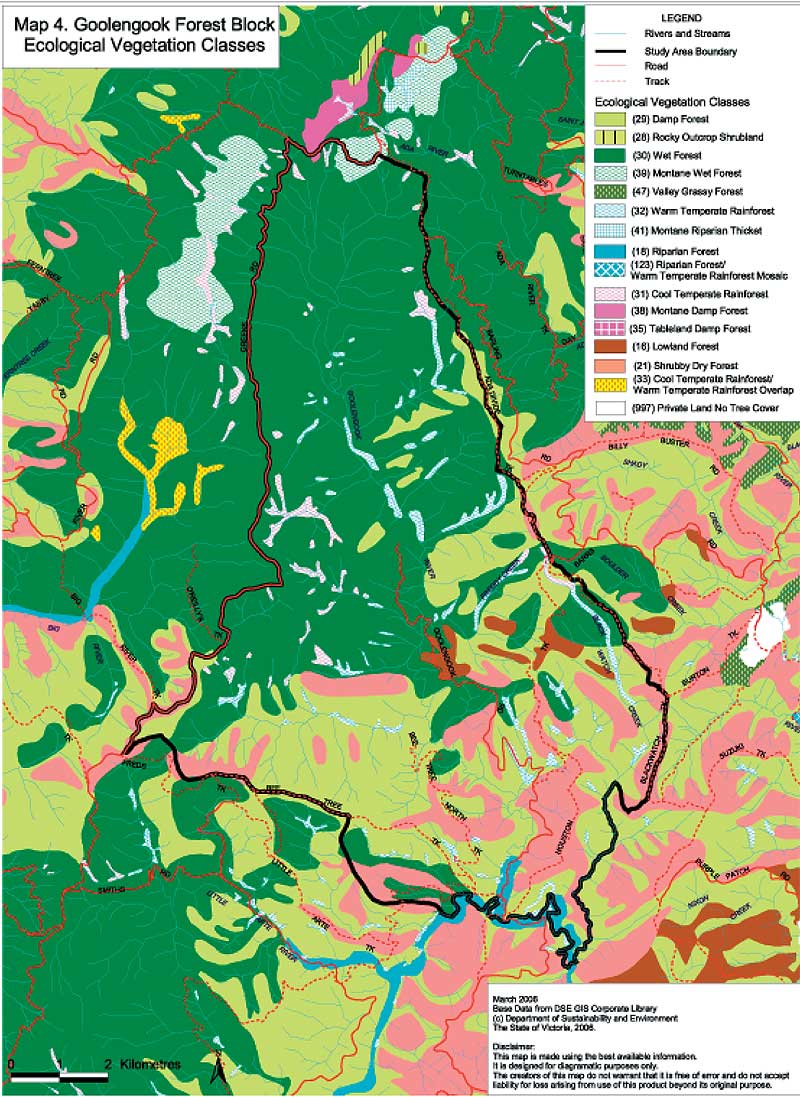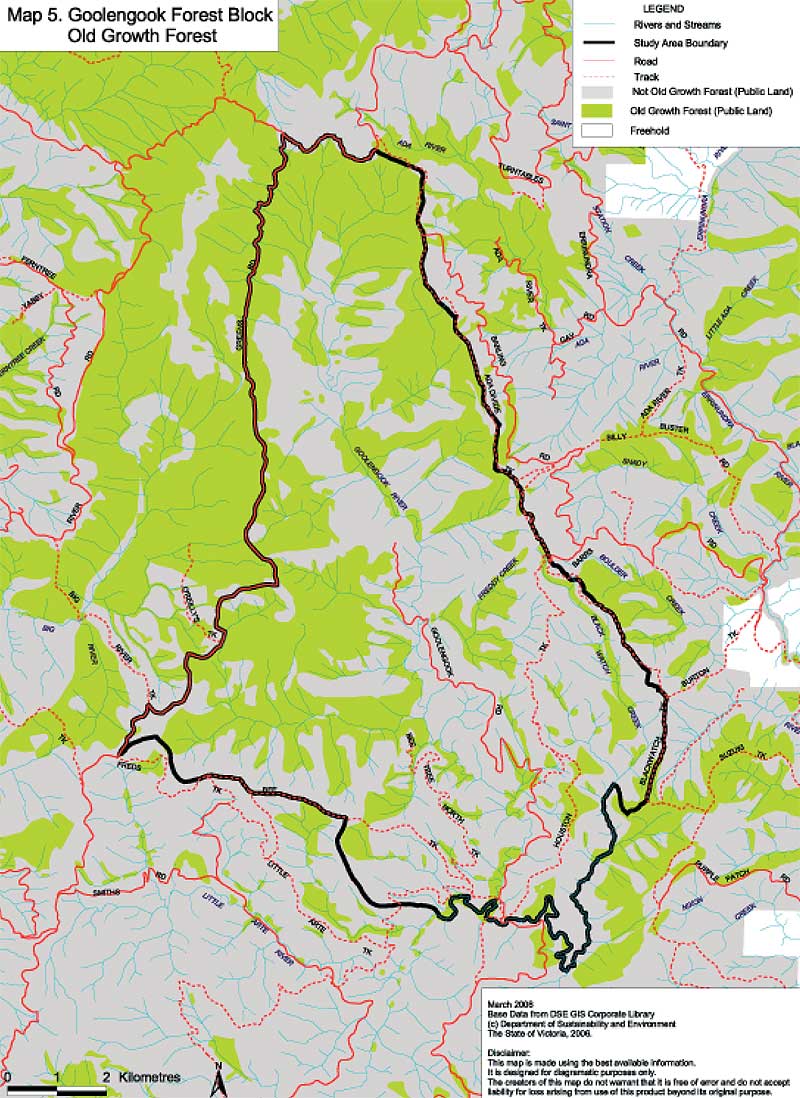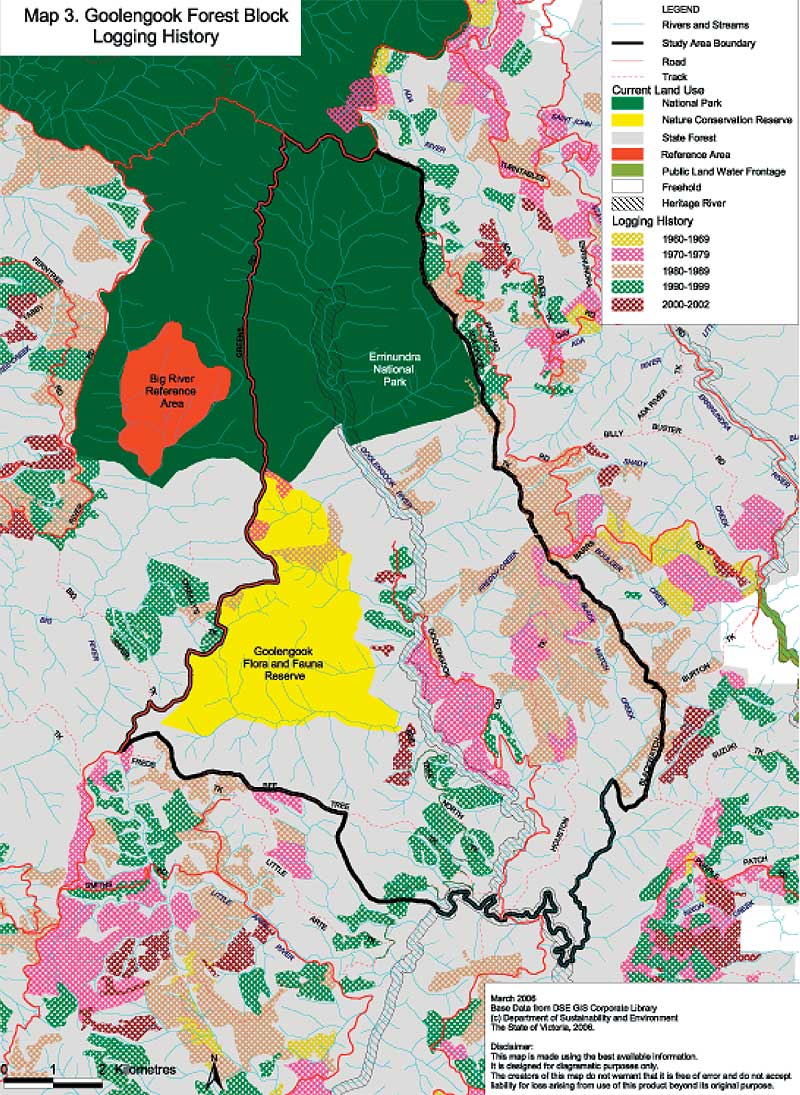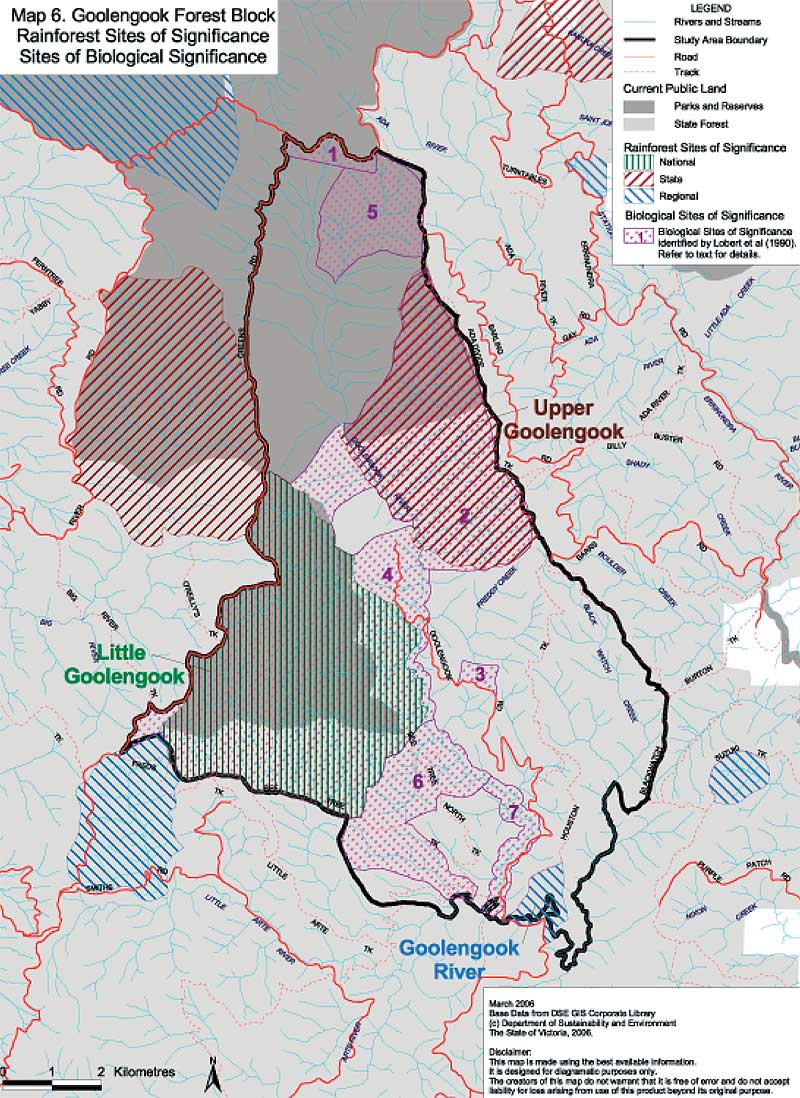Goolengook forest campaign 1996-2009
Also on this page:
Protest History
2002 State Election
2006 State Election
References and Links to other websites
Location and Values
Goolengook is a large tract of relatively undisturbed bio-diverse native forests (includes old growth and rainforests) at the southern end of the existing Errinundra National Park. The total area is about 9000 ha with a bit over half (53%) State forest. The balance is already in nature conservation reserves.
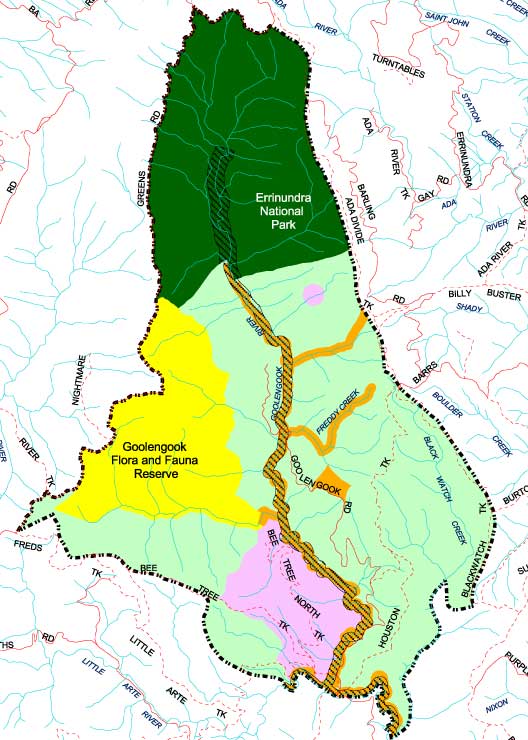 9000ha Goolengook area. Click to enlarge (pdf) |
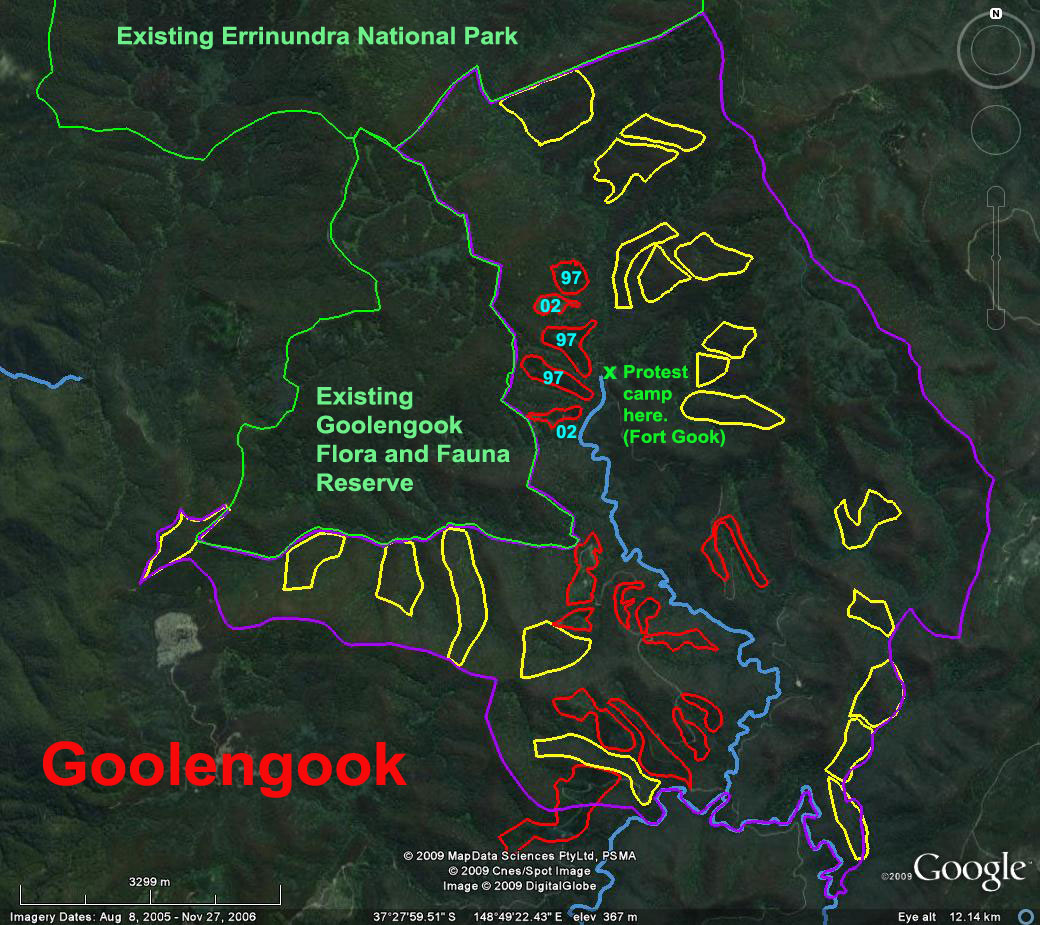 Click map to enlarge. (This image was taken the day after the 2006 State Election.) Purple line = Goolengook State forest area (3000 ha) to be protected. Yellow line = Coupes that will now not be clearfell logged . Red line = coupes logged from 1990's onwards Green line = Existing National Park Boundry. Year = Year different areas were clearfell logged. |
During the 2006 State election the Victorian State Government made a commitment to put the 3000 ha of State forest at Goolengook (available for clearfell logging) into existing National Parks. (This includes about 710 ha already been clearfell logged).
At threat of being logged is at least 600ha of wet and damp old growth forest in State forest*.
* See VEAC Goolengook overview report (page 9).
Goolengook also has three Rainforest Sites of Significance.
1. RSOS Site 72, National, Little Goolengook. (will be fully protected)
2. RSOS Site 73, State, Upper Goolengook. (will be fully protected)
3. RSOS Site 67, Regional, Goolengook River.(will be fully protected)
Below are maps from the VEAC overview report that provide information regarding the nature conservation values at Goolengook. (Click on maps.)
Vegetation Classes |
Old Growth |
Logging History |
Sites of Significance |
Protest History
From 1996 a small group of conservationists began a campaign to prevent further road construction and clearfell logging of the Goolengook valley. Similar to the Sellers Road blockade a few years earlier, a small base camp was setup on a newly constructed bridge over the Heritage listed Goolengook river (on Goolengook road).
The success of the Goolengook campaign was strongly influenced by its location. Compared to most previous East Gippsland protest camps, Goolengook had the strategic advantage of being much closer to the Princes Highway. It was easier for people to find and get to the protest camp on their own initiative.
The earlier East Gippsland protestors of the 1980’s and early 1990’s had to first drive to distant Orbost and then two hours on dirt roads to get to remote Goongerah. At Goongerah conservationists needed to then get directions to safely drive on rough dirt roads to find protest camps on the remote Errinundra plateau (where almost all East Gippsland protests had previously concentrated). The remoteness of protest camps added logistical difficulties of increased costs for fuel and time. The vastness and distance of East Gippsland meant that for most young forest activists, they simply did not have the personal resources to commit to protecting the area at short notice for extended periods of time. For example in the summer of 1994, the East Gippsland Forest Alliance had to supply fuel for people to get to protest camps.
Easier access to Goolengook meant that a huge number of people could became familiar and committed to the Goolengook protest camp within a short time.
The small band of conservationists with virtually no support from peak environment groups, networked Goolengook up and down the East Coast of Australia.
On the 4 June 1997 government road builders turned up and began extending the Errinundra road a further two kilometres into the Goolengook forest wilderness. Over the next six months 177 people were arrested1 for obstructing the three areas that were clearfell logged along this new road extension.
160 of the protestors arrested, argued in court that the logging was unlawful as it was within 200 metres of the heritage listed Goolengook river. Amongst the masses arrested was Greens political party leader and Federal Tasmania Senator, Bob Brown. It was decide to use Bob Brown’s high public profile along with two co accused as a test case in the courts. In February 1998 the Moe magistrates court found the logging was in breach of the Heritage River act and Bob Brown and the two co-accused were acquitted.1 & 2
In April 1998 the Kennett Government responded by introducing legislation to amend the Heritage Rivers Act. The legislative changes reduced the protection buffer along the Goolengook river from 200 to 100 metres. The government claimed this was done to validated timber harvesting since 1992. This naturally outrage the conservation movement and inflamed the debate.
Also adding fuel to public discontent was the Kennett Government’s introduction of the Forest Operation Zone Legislation in 1998. This legislation made large areas of East Gippsland and the Otways no go zones where the public could not enter without a permit. The zones were designed to stop protests, only allowing entry to people associated with logging and with authority.
Due to the combined efforts of Goolengook and Otway forest activists, a great deal of public debate about Forest Operation Zones was created.
In September 1999 the Kennett Government suffered a political backlash in the State election. By November 1999 the minority Bracks government took over control of the State forests. Bracks was elected with a policy to reinstate the 200 metre Goolengook heritage river buffer and remove the Forest Operation Zone legislations. (See ALP 1999 environment policies).
In the end, changes against all 160 of the 177 arrested in 1997 were dropped.
From 1998 onwards conservationist maintained a permanent presence at Goolengook which lasted for over five years. Events such as Wood-Stop 1999 and numerous fundraising and awareness events kept the broad community engaged in the Goolengook campaign.
In February 2000, an ugly incident occurred when a group of 40 men connected to the logging industry made a midnight raid on the Goolengook protest camp. They smashed equipment and vehicles (including overturning a vehicle). Many forest activists were assaulted. This incident may have been provoked by an earlier incidence that day when conservationists and traditional owners of the land had approached logging contractors in nearby forests. It was alleged that an argument broke and alleged punches thrown between both sides*. 3
(*Which, if true, was a breach of the principles of non-violent direct action for which the majority of social change activists adhere to.)
In May 2002, ten of these men pleaded guilty and were given suspended gaol sentences. 4
In response to the attack conservationists built a large structure named Fort Goolengook as a show of defiance . The fort included a moat and drawbridge installed for added security.
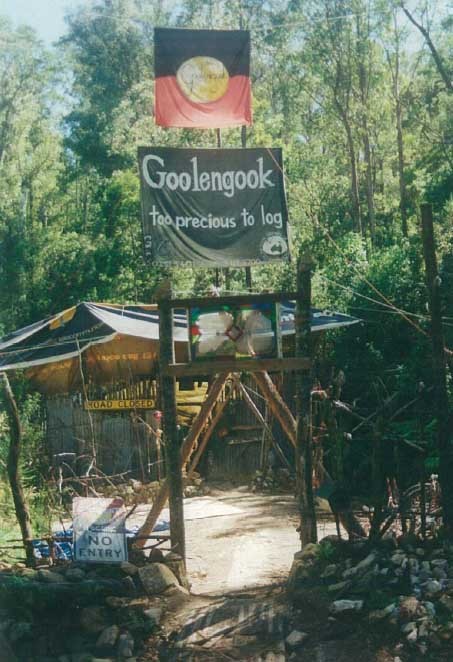
Fort Goolengook. Photo Trevor Poulton.
The State government announce in February 2002 that that sustainable sawlog yields would be cut by 50% in East Gippsland due to over logging. This cut had the effect of reducing the overall size of the East Gippsland native forest logging industry.
In a move that appeared to be a bid to appease the logging industry, the Government decided to re-commence logging at Goolengook.
By March 2002, the final large conflict began. Police moved in and dismantled Fort Goolengook which was reported in the media as the longest running forest blockade in Australian history (5 years). A new 25km exclusion zone was set up around Goolengook and permanent police presence put in place while more two more coupes were clearfell logged in the heart of Goolengook. Despite the exclusion zone over a three month period a further 75 people were arrested trying to obstruct the logging. Protestors had to walk long distance to get to the coupes to hinder logging operations in protest.
The media reported that the government resources deployed by the government to stop and remove protestors was double the value of the wood being removed. 5
2002 Victorian State Election
In late October 2002, the ALP state Government announced a logging moratorium at Goolengook while Victorian Environmental Assessment Council(VEAC) undertook an assessment of the environmental values.
The Wilderness Society and many Greens political party members criticised the Governments Goolengook announcement. It was described as a “election gimmick” by the Bracks government only done to "prevent the leakage of votes to the Greens”. 6
The government made it clear that there would be no overall loss of timber resources to protect Goolengook. Conservationists were concerned that this would require an area of Old Growth forest outside the Goolengook area currently in a Special Protection Zone to be exchanged for logging to save old growth forest at Goolengook. This was clearly not acceptable for conservationists.
However the logging moratorium at least meant that the protest camp at Goolengook could be packed up after being in place for over five years as further logging was no longer imminent.
The following week the State Government announce all native forest logging in the Otways would end by 2008 and a new Great Otway National Park would be created, its boundaries to be determined by a VEAC assessment.7
This Otways logging ban was electorally popular and contributed to the Bracks Government being re-elected8 with the biggest Parliamentary majority in the history of the Victorian State Parliament.8a
The relationship between some of the peak Victorian forest campaign groups and the electorally popular Bracks government was at an all time low. Shortly after the election the State government made it publicly clear that some conservationists who were also members of the Greens political party and the Wilderness Society would be “on the outer” with the Bracks Government. 8
As a consequence the Bracks Government was slow to get the Goolengook VEAC study started. The Otway VEAC study was made the priority.
In December 2005 (three years after the Goolengook moratorium started) the State Government finally announced the terms of reference for the Goolengook inquiry. The terms of reference dropped the requirement to maintain logging rates by exchanging Special Protection Zones. Also the entire Goolengook block was now to be investigated, not just old growth forest values.
VEAC released a Discussion Paper in May 2006.
VRN wrote a submission to the VEAC Goolengook inquiry.
The Save the Goolengook Desk publicly welcomed the VEAC terms of reference. (add media)
Another process also began in February 2006 to resolved the timber resources issues fro Goolengook. The State Government set up the Steedman and Gooding assessment process for East Gippsland to investigate different options for protecting more forests while at the same time maintaining timber resources. In part, this process was set up in recognition that swapping old growth forest areas currently protected from logging to save forest at Goolengook was politically not acceptable.
Four years passed (since the Goolengook moratorium was declared) and another Victorian State election came around.
2006 Victorian State Election
During the November 2006 State election, the ALP State Government announced a new East Gippsland forest policy based on the findings of the Steedman and Gooding process. The Government would abandon the VEAC inquiry and simply make all of Goolengook a National Park as part of 41,000 ha area to be protected. The Government claimed that this protection could now be offered with no reduction in timber resources.
Almost a decade had passed since the first protest camp had been set up on the Goolengook river and now the Government was to make the whole area a National Park.
There was a mixed reaction from conservation groups to the announcement that Goolengook would be added to a National Park
On the day of the ALP policy announcement Friends of the Earth campaign co-ordination Cam Walker welcomed the protection of Goolengook.
“Protection of Goolengook Block and 5000 hectares of additions to the Great Alpine National Park are very welcome but there are still thousands of hectares which should be immediately included in the national park and reserve system.” 9
However some peak conservation groups and Greens political party candidates again condemned the State Government during the 2006 election campaign arguing that a vastly greater area in Victoria should be protected than what was on offer. (977,000 ha as proposed by the Victorian Forest Alliance)
The Wilderness Society condemned the ALP East Gippsland policy despite the fact about 250 people had been arrested at Goolengook between 1997 and 2002.
But the Wilderness society condemned the Bracks announcement, accusing Labor of failing to protect old growth forest. “Its about 10 percent of what we wanted” said Gavan McFadzean, the society Victorian campaigns manager. “Its a step, but it’s a very small step. They should have protected all of Victoria’s old growth forest, which isn’t’ as radical as it sounds.10
However the State Government was also under pressure from the logging industry. Days before the announcement, the local independent MP Craig MP Craig Ingram warned that the loggers would launch a Jihad similar to that they applied to the former Federal ALP leader Mark Latham's failed election policy to protect old growth forests in Tasmanian during the 2004 Federal election.11
Bracks was aware the Forestry Union with significant financial backing from the East Gippsland logging and pulp and paper industry was capable of sponsoring logging candidates to stand and directed preferences to the Liberal Party in protest against ALP pro-forest conservation policies. This had occured during the 2002 State election (Seat of Morwell**) and the 2004
Federal election (Seat of Gippsland12),
(**See OREN website for Morwell 2002 election details.)
Media discussion of the 2006 ALP East Gippsland policy focused on the balancing act between conservation gains without reducing sawlog commitments or jobs. The Bracks government claimed it had the balance worked out for East Gippsland.10
The CFMEU forestry division secetary Michael O'Connor backed the policy to protect Goolengook as a compromise outcome.
O'Connor was quoted as saying, "We think this policy is a rejection of an extreme green agenda and it will give us what is necessary for a sustainable industry for our memebers."10
Bracks was easily re-elected in 2006.
Conservation activists who has been working on the front line declared victory. According to the GECO website (accessed September 2009) :
Finally after ten years the government has promised to include Goolengook in its entirety into the Errinundra National Park. Its immediate protection is a win for all the people who worked so hard over so many years to protect the place - the hundreds arrested, the thousands who visited, wrote letters, protested and fought day in day out for the forests of Goolengook. Well done to you all!
Again the State Government has been slow to implement legislation to add Goolengook to the National Parks system. This is due in part to peak conservation groups and members of the Greens political party continuing to agitate for a vastly larger area of forest in Victoria for protection than the 41,000 ha areas currently on offer that includes Goolengook.
Two years later (February 2009) the Government released a Statement of Intention that acknowledged that there would be refinement of the protected areas of forests in East Gippsland before legislation to create new national parks would be put before parliament later in the year.
In May 2009, peak environment groups (ACF, Wilderness Society and VNPA) released a joint report titled Flawed Promises which attacked the ALP 2006 East Gippsland policy. Flawed Promises has no positive reference towards the fact that the Goolengook area is to be protected.
To date the campaign to get Goolengook added to the National Park reserve system has been running for 13 years.
Goolengook is still State forest were a logging moratorium is in place. Legislation has yet to be passed in Parliament to make this area a National Park.
References
1. Timber felling areas was illegal, Browns Lawyer tells magistrate. Manike Naidoo. The Age. 10/12/1997.
2. Logging limit eased in heritage river Zone. Geoff Strong. The Age11/4/1998.
3. Government urged to step in as forest conflict intensifies. Claire Miller, The Age. 23 February 2000.
4. Men get suspended jail terms over forest raid. ABC Radio. 23 May 2002.
5. Otways Logging Battle Set To Ignite. Claire Miller, The Age. 11 April 2002.
6.Goolengook moratorium an election gimmick, protestors. AAP. 30 October 2002.
7. Bracks Otways Pledge. End to Logging. Wade Pearce. Geelong Advertiser. 7 Novebmer 2002. (Front Page).
8. Environment: Greening of the government. Melissa Fyfe. The Age. 2nd December 2002.
8a. Bracks by a mile. Kirsty Simpson. The Sunday Age. 1st December 2002.
9. Stated in a joint Environment Group Press Release. 17 November 2006.
10. No Forestry Jobs Will go, Bracks pledges. Rick Wallace. The Australian. 18 November 2006.
11. Timber workers in threat of ‘jihad’. Rick Wallace. The Australian. 16 November 2006.
12. Pro-logging candidate is Potential Kingmaker in Gippsland. AAP. 24 September 2004.
Goolengook Protest Websites
Archive websites:
Official Goolengook website: Not been updated since 2002.
Save Goolengook desk: Last updated 2006.
GECO webpage: Last updated 2006.
Forest Network: Last updated 2002.
The image below shows the Goolengook forest block as a thick yellow line. Goolengook is located at the southern end of the Errinundra National Park shown as a red line.
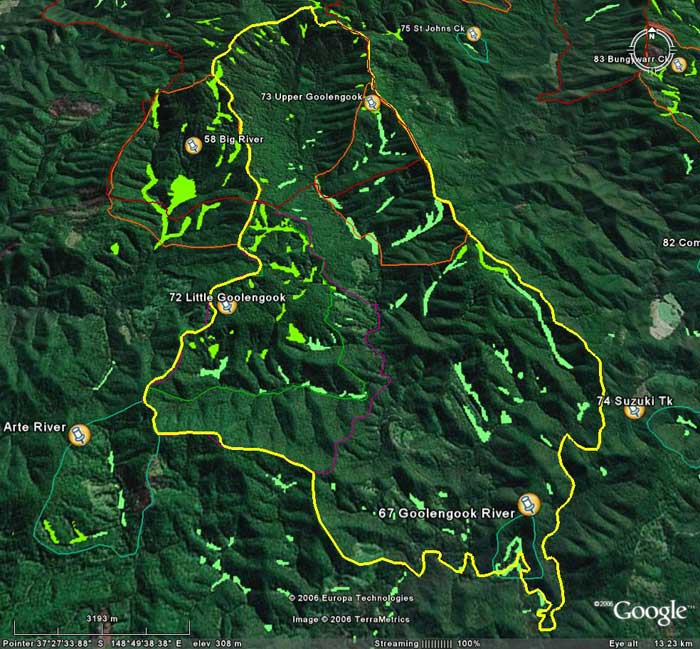 Download hi res PDF of this image
Download hi res PDF of this image
The thick yellow line(download for Google Earth ![]() ) marks the boundary of the VEAC study area.
) marks the boundary of the VEAC study area.
The image above shows three RSOS (67,72,73) within the Goolengook forest block along with a significant amount of cool, warm and warm overlap temperate rainforest.
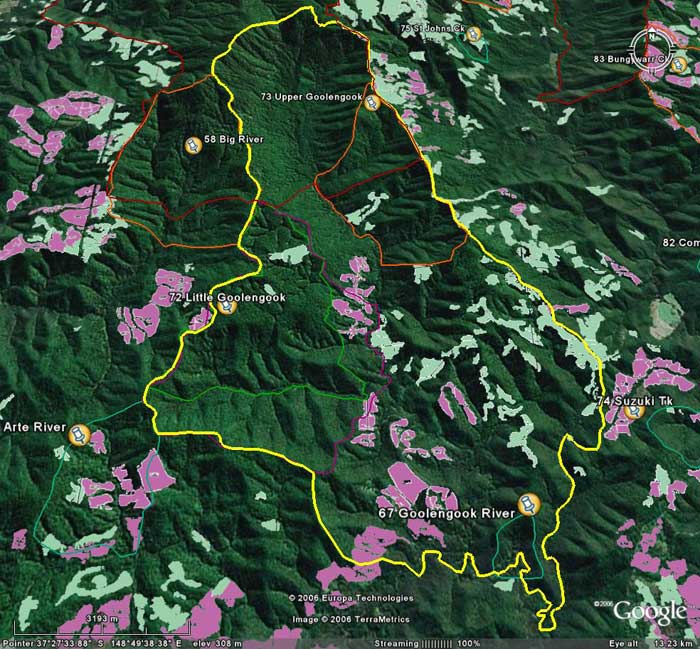 Download hi res PDF of this image
Download hi res PDF of this image
Clearfell logging history within the Goolengook forest block. A significant about of old growth forest outside the southern end of the Errinundra National Park(red line) is at stake.
